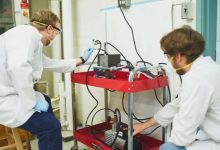Don’t panic when you see paramedics with masks. It’s not necessarily a coronavirus case
Amid the global coronavirus outbreak, masks have been flying off shelves in cities across the country and viral videos are sparking concern over paramedics spotted in protective gear.
In one recent instance, video footage from a flight from China to Toronto showed Peel paramedics decked out in various types of masks — including one wearing a full clear-plastic face cover — while transporting a patient off the flight.
The footage got thousands of views and shares after being re-posted by different accounts, and prompted plenty of speculation over the patient having coronavirus.
But Brad Bowie, the community relations officer for Peel Regional Paramedic Services, says it wasn’t a suspected coronavirus case at all, though the video was indeed showing paramedics taking standard precautions.
So what’s the real purpose of personal protective equipment for paramedics? And what does it have to do with the virus that’s spreading to countries around the world?
CBC Toronto spoke to experts like Bowie to break it all down:
When do paramedics wear protective gear?
Anytime their own health could be at risk, paramedics don protective gear, says Bowie. That means if a patient is coughing, sneezing, or bleeding profusely — when airborne droplets or bodily fluids are flowing — it’s time to suit up.
Sometimes that decision happens on-site, but there’s also pre-screening in place so paramedics know what they’re getting in to.
Dineen Robinson, a spokesperson for Toronto Paramedic Services, says its communications centre screens for a “range of emerging infectious diseases” when patients call with respiratory or gastrointestinal issues and have recently travelled outside of Canada.
“Any such information that is obtained from callers is then communicated to frontline staff attending those calls for emergency service,” she says.
Amid the coronavirus outbreak, the province has also implemented “enhanced screening measures” at all emergency medical services’ communication centres to identify potential cases before dispatching paramedics, Dr. Barbara Yaffe, associate chief medical officer of health in Ontario, recently said.
What protective gear is available?
Bowie says there’s a whole slate of personal protective equipment, or PPE, available to paramedics.
Gloves are an everyday staple worn on all calls, he says. There are also face shields to protect paramedics from airborne droplets, and a variety of masks.
Gowns are also available, and in rare cases paramedics will resort to full-body covering — but that’s usually just for extreme cases of infectious, potentially-deadly diseases.
Why so many different masks?
Generally, paramedics will put on a disposable N-95 respirator mask; they’re usually white, sometimes duck-bill shaped, and loop around the back of your head.
It’s a simple way to protect someone from breathing in 95 per cent of all airborne particles, be it droplets from a patient coughing or dangerous dust or mould.

But Bowie says the style doesn’t work for all paramedics, who are regularly fit-tested to make sure they’ve got a mask that protects them. At times, some people need different styles of mask to accommodate certain facial sizes or structures, skin reactions, or even facial hair like a beard.
Those paramedics might need to upgrade to other styles, including a full face shield that has a tube to filter in clean air.
If you see the gear, does that mean the patient has coronavirus?
It’s possible, but probably not.
Bowie says protective gear is a precaution for a variety of medical issues, including the new coronavirus. But it’s definitely not a clear indication of the type or severity of a patient’s illness — it’s just a way for paramedics to protect themselves and their loved ones from getting sick.
The equipment and guidelines “are not new to our staff and are part of normal practice,” echoes Robinson, speaking for Toronto Paramedic Services.
“These are the same precautions that frontline staff use when dealing with any type of infectious disease, including SARS and Ebola.”
But given current concerns about coronavirus, Bowie adds, people may spot paramedics wearing the gear on a more regular basis.
Do precautions have anything to do with SARS?
Clinicians learned a lot from the deadly SARS outbreak in Toronto, which helped boost infection control protocols and prompted widespread adoption of personal protective gear, Bowie says.
SARS, or severe acute respiratory syndrome, also spread from a strain of coronavirus. The illness killed hundreds of people and afflicted thousands more around the world in the early 2000s — and in the Toronto area, it mainly hit healthcare workers.

Bowie says before that wake-up call, emergency responders didn’t worry much about protective gear.
“We didn’t always think about wearing gloves. We didn’t always think about wearing masks,” he says. “It just wasn’t on our radar as daily safety precautions.”
The bottom line nowadays? It’s better to be safe than sick.
“Paramedics are going to spend a lot of time in the back of an ambulance with these patients,” Bowie says.
“So they’ve got to protect themselves.”
CBC








Redes Sociais - Comentários